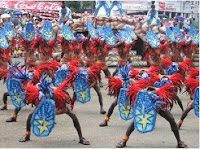 Santa Claus originated from Saint Nicholas, a bishop of Myra in the province of Lycia (which is now a part of Turkey) in the 4th century. Born in a wealthy family during the 3rd century in the village of Patara, he was raised to be a devout Christian who dedicated his life serving God, assisting the needy, the sick and the suffering that he was later became known throughout the land for his generosity for those in need, his love for children and his concern for sailors and ship.
Santa Claus originated from Saint Nicholas, a bishop of Myra in the province of Lycia (which is now a part of Turkey) in the 4th century. Born in a wealthy family during the 3rd century in the village of Patara, he was raised to be a devout Christian who dedicated his life serving God, assisting the needy, the sick and the suffering that he was later became known throughout the land for his generosity for those in need, his love for children and his concern for sailors and ship.
During the reign of Emperor Diocletian, Christians are persecuted and imprisoned. After his release, Nicholas attended the council of Nicea in AD 352. He died December 6, AD 343 and was buried in his cathedral church in Myra, where “manna” a unique relic that formed in his grave is said to have healing powers that fostered the growth of devotion to Nicholas particularly in Russia where along with Saith Andrew, he became the patron of the nation. But the reaction against the saints during the reformation led to Saith Nicholas' eclipse in all the predominantly  protestant countries of Europe except Holland, where he was known there as Sinter-Klaas, an alteration of Saint Nikolas, and his traditions were taken to New Amsterdam (now New York) by dutch colonist in the 17th century.
protestant countries of Europe except Holland, where he was known there as Sinter-Klaas, an alteration of Saint Nikolas, and his traditions were taken to New Amsterdam (now New York) by dutch colonist in the 17th century.
In 1809, under the pseudonym of Diedrich Knickerbocker, it was Washington Irving's fanciful description in his book Knickerbocker's History of New York who gave Americans their first detailed information about the Dutch version of Saint Nicholas and with some adaptations, Sinter-Klass was appropriated by the English settlers under the name of Santa Claus.
The English Santa Claus and the Dutch Sinter-Klaas carry out an identical mission in the same extra ordinary way: they enter the houses from the roof through the chimney and deposit gifts for their children in shoes and stockings. There are however notable differences between them. In Holland the figure is definitely a saintly bishop whose activities takes place on December 6 (the date of his death which also became his feast day) and have no connection with Christmas. The Dutch saint arrives on horseback, not by sleigh, after a sea journey from Spain and as a bishop, he does not have a wife. He is always accompanied by Zwarte Piet (Black Peter, his Moorish servant).
In 1823, Clement Clarke popularized the poem A visit From Saint Nicholas or more commonly known as The Night Before Christmas that made this Dutch-American Saint Nick achieved his fully Americanized form. Moore included such details as the names of the reindeer; Santa Claus' laughs, winks, and nods.; and the method by which Saint Nicholas, referred to as an elf, returns up the chimney.
Christmas issues of Harper,s magazine from 1860s to 1880s further elaborated the American Image of Santa Claus. Illustrator Thomas Nast depicted a rotund Santa and added details such as Santa's workshop at the North Pole and Santa's list of the good and bad children of the world. A human-sized version of Santa Clause, rather than the elf of Moore's poem.
However in 1925, since grazing reindeer would not be possible at the North Pole, newspapers revealed that Santa Claus in fact lived in Finnish Lapland. Markus Rautio revealed the great secret for the first time in a Finnish public radio in 1927 that Santa Claus lives on Lapland's Korvatunturi - "Ear Fell". The fell, which is situated directly on Finland's eastern frontier, somewhat resembles a hare's ears - which are in fact Santa Claus's ears, with which he listens to hear if who among the world's children are being naughty or nice. Santa has the assistance of a busy group of elves, who have quite their own history in Scandinanvian legend.
The very popular Rudolph the red nosed reindeer with a shiny nose, is the ninth reindeer and was invented in 1939 by an advertising writer for the Montgomery Ward Company.
 Santa Clause that we now know is the combination of many different legends and mythical creatures. Several centuries and a combination of different customs from different parts of the Northern Hemisphere has created the whole world's Santa Claus - the ageless, timeless, deathless white-bearded man who gives out gifts on Christmas and always returns to Korvatunturi in Finnish Lapland.
Santa Clause that we now know is the combination of many different legends and mythical creatures. Several centuries and a combination of different customs from different parts of the Northern Hemisphere has created the whole world's Santa Claus - the ageless, timeless, deathless white-bearded man who gives out gifts on Christmas and always returns to Korvatunturi in Finnish Lapland.
Since the 1950s, Santa has happily sojourned at Napapiiri, near Rovaniemi, at times other than Christmas, to meet children and the young at heart. By 1985 his visits to Napapiiri had become so regular that he established his own Santa Claus Office there. He comes there every day of the year to hear what children want for Christmas and to talk with children who have arrived from around the world. Santa Claus Village is also the location of Santa's main Post Office, which receives children's letters from the four corners of the world.




















